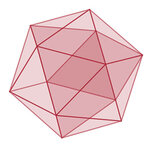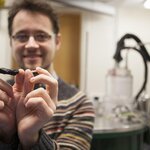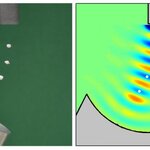Applied Physics

A nonflammable electrolyte may bring us safer lithium-ion batteries.
“With current lithium batteries safety is engineered through the battery management system,” says Lawrence Berkeley National Laboratory researcher Nitash Balsara, co-founder of Blue Current, a startup company to further develop their invention. “Although they are generally considered safe, you still have an electrolyte in the battery that is flammable, and every so often something might go wrong. We want to take that anxiety out of the battery.”
The electrolyte is a chemical substance that carries electrical charge…

Indian swords don't get a lot of cultural respect compared to the works of Spain or Japan but a new study used two different approaches to analyze a shamsheer, a 75-centimeter-long sword from the Wallace Collection in London, and found that it was master craftsmanship
The study, led by Eliza Barzagli of the Institute for Complex Systems and the University of Florence in Italy, used metallography and neutron diffraction to test the differences and complementarities of the two techniques. The shamsheer was made in India in the late eighteenth or early nineteenth century and is…

The world of single atoms and molecules may seem to be governed by chaotic fluctuations, but a team of researchers has found that the spontaneous formation of Turing patterns - responsible for the irregular yet periodic shapes of the stripes on zebras' bodies - can not only occur on the small scale, but can also be used for potentially very interesting applications.
Everyone is familiar with a zebra's stripes, but not everyone knows that these are the manifestations of chemical reactions taking place according to a process first described by the famous British mathematician Alan Turing, the…

By: Marsha Lewis, Inside Science
(Inside Science TV) – They may look flimsy, but the materials printed with 3-D printing technology are one-of-a-kind, light-weight and super-strong.
Materials engineers at LLNL have created a material with a special 3-D printer that mixes hard metal, tough ceramics and flexible plastics.
“It can hold more than 100,000-times its own weight. In fact, even more than that," said Chris Spadaccini, a materials engineer at Lawrence Livermore National Laboratory in California.
“One of the benefits of this methodology is the ability to work with a wide range of…
My wife bought me a “selfie-stick” (sometimes called Wand of Narcissus), which is ironic since I so rarely actually take selfies. But, once I took a look at its simplicity of design, I couldn’t leave well enough alone and decided to create the “Super Selfie-Stick.”
At first I tried attaching a camera mount on the end of a golf ball retriever. But with the shorter ball retrievers, it turns out that the flimsy aluminum that they’re made of tends to make them kind of wobbly and could lead to motion blur in the shot. A longer golf ball retriever, however, may provide a little more stability.
I…

Spider-Man's breakfasts must be unreal levels of eggs. warriorpoet
By Mark Lorch, University of Hull
While stuck in a hotel room I got sucked into watching the 2002 "Spider-Man" movie. And it struck me that Peter Parker must have an enormously high-protein diet to generate all that spider silk he goes through. So being the geek that I am, I wondered what his protein consumption has to be to sustain his villain-beating lifestyle.
I think we can work it out with a bit of school-level physics, maths and some basic biochemistry. We will need to work out the strength of Spider-Man’s silk,…

Glass looks like it is solid but telling a materials engineer that glass is a solid is like telling an aerospace engineer Bernoulli is why planes fly (or Newton, for that matter - whichever you say, they will argue the opposite).
Glass flows - but slowly. The question is does it ever really stop flowing? Researchers at the University of Bristol and Kyoto University used computer simulation and information theory to try and settle this long-standing bar bet in the physics community.
First, the premise: We know glass flows at high heat because we have all seen glass blowers shape swans and such…

Splash form tektites are tiny shards of natural glass created from spinning drops of molten rock flung from the earth during an extra-terrestrial impact, such as when the earth is hit by asteroids or comets.
They come in many shapes, from dumbbells to doughnuts, and how the shapes are formed has been the subject of scientific investigation for centuries. Until now, the shapes of rapidly spinning, highly deformed droplets have been derived entirely from numerical simulations.
Using magnetic levitation to imitate weightlessness, researchers have manufactured solid wax models of these…

Acoustic levitation has been done in the past but it required a precise setup where the sound source and reflector were at fixed "resonant" distances. This made controlling the levitating objects difficult and isn't really proof-of-concept for anything practical.
Now a team of researchers have developed a new device that can levitate polystyrene particles by reflecting sound waves from a source above off a concave reflector below - with more control than any instrument created before. Changing the orientation of the reflector allows the hovering particle to be moved around.
The…

We don't often think of snakes as flying creatures - a lack of wings does not lend itself to flying imagery - but some snakes can glide as far as 100 feet through the air, jumping off tree branches and rotating their ribs to flatten their bodies and move from side to side.
New research from a George Washington University professor investigates the workings behind the flight and whether they can be applied to mechanical issues.
Lorena Barba, associate professor of mechanical and aerospace engineering in the GW School of Engineering and Applied Science, and her team, including Anush Krishnan,…